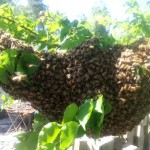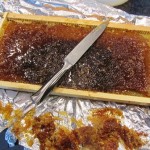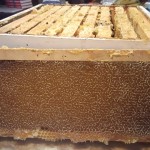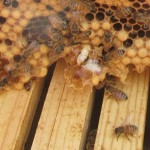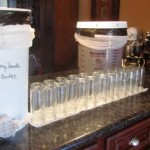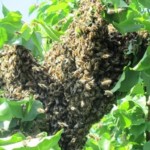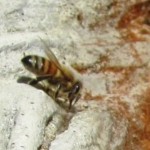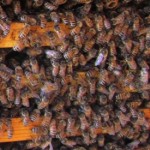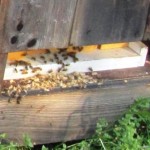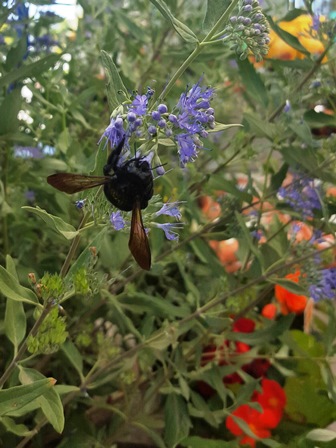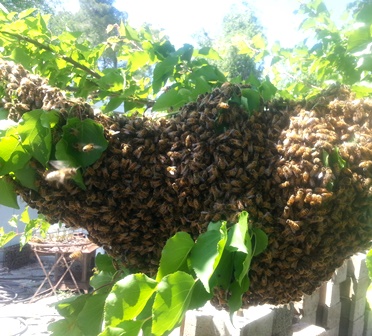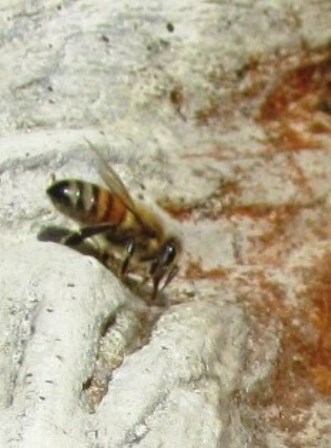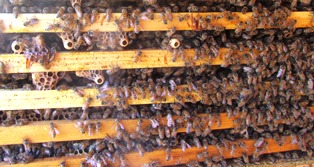Archive for the 'Insects' Category
Keeping Bees Feeds the Family
The sight of bees collecting pollen makes me happy. Always has. Honeybees are vital to the production of the foods we love such as almonds, apples, citrus, melons, and a large variety of vegetables. My vegetable garden and fruit trees are incredibly productive because of my backyard bees. I guess you could say they feed my family through pollination.
Bees are pollinators. Without them there’s a good chance we’d suffer food scarcity on our planet. Three out of four crops around the globe that are foods that we humans eat are dependent in large part on pollinators. Honeybees also produce honey, nature’s most delicious sweetener, in my opinion.
I keep hives of honeybees on my farmette. It’s not a commercial operation but a backyard hobby that supplies honey for my family and friends as well as pollinating a huge variety of vegetables, fruits, and berries that I grow. Caring for the bees is relatively easy. Harvesting honey, on the other hand, is a bit of work but work I am happy to do.
The first step in harvesting honey is to open the hives. The use of a smoker helps calm the bees. Working quickly is a good idea. We never remove all frames of honey from the hive, but rather leave frames with baby bees and some frames with honey so the bees have food, too.
New frames (some are previously used frames that have the wax structure intact) are inserted to replace the removed frames of honey. A super with 10 frames of honey is carried into my kitchen. Inevitably, I have to capture and release a half dozen live bees that ride in on the frames.
Each frame then gets a hot knife slipped just under the layer of wax. With the wax removed from both sides of the frame, only honey is left. This must be spun out or drained off.
I put four frames of honey at a time into the spinning machine in my kitchen. Beneath the machine’s spigot is freshly washed honey bucket, draped with a new cloth strainer that I’ve taped in place over the top of the bucket. It will catch any pieces of wax or other debris.
When the bucket is full, the strained honey is poured into jars to use, store, or give away as gifts. I put a tight-fitting lid on the bucket and keep the bucket within easy reach on the kitchen countertop.
We eat honey year round. I especially love it in the winter because it reminds me of the honey-flow in spring when the farmette smells like honey and my kitchen is saturated with the scent after pulling some frames from the hive.
Also, the vegetables and fruits that I harvest throughout the growing season are either immediately consumed or preserved through hot-water canning, dehydration, flash freezing. I thank Mother Nature for the blessing of bees that pollinate our foods and give us delicious honey from their hive–up to six gallons for ten frames from a full-depth box!
*NOTE: Learn more about honey bees at: https://www.nationalgeographic.com/animals/invertebrates/h/honeybee/
Also, check out: https://honeybeenet.gsfc.nasa.gov/Honeybees.htm
___________________________________________________________
Enjoy reading about country living? Check out my Henny Penny Farmette series of cozy mysteries that also include lists of farm chores, delicious recipes, farm sayings, and tips for healthy living. Or, take a look at my health, wellness, and spirituality books. All are available online and everywhere books are sold.

More than 150 rituals for sound mind, strong body, and meaningful connections to the people around you
Harvesting Honey–Helping Hands Always Welcome
When it comes to opening the hives of honey bees here on our farmette, I’m grateful for the helping hands of my hubby and my neighbor. Carlos, my hubby and helpmate for life, is my go-to guy for all our farm projects. And our neighbor Peter not only has answers to my questions about bees, but also he can open a hive, remove frames of honey, inspect and medicate, and seal the unit lickety-split.
With the smoker at the ready and lit, we opened our hives September 23, 2018. The hives were robust, but the bees appeared stressed. I had added supers to each hive in late July but should have kept a closer eye on the burgeoning bee population. They had become overcrowded and hungry.
For harvesting, we first removed the heavy metal lid of the hive box, replacing it with a fume board. A fume board is a lid lined with fabric that is sprayed with a product that encourages the bees to vacate the supers (some bees immediately leave the box; others go into the brood chambers). The fume board works within seven to ten minutes. We then pulled out the frames of honey, gently brushed off any remaining bees, and took the honey-heavy frames to the kitchen.
For an old hand at beekeeping like my neighbor, the process went quick. Not so for me. This past year, I injured both my shoulders with tears in the rotator cuff tendons. With limitation to some of my range of motion, I’ve felt pretty handicapped. Still, I helped by carrying a single frame of honey at a time from the hive box to the kitchen.
While the hives were open, we removed old medicated strips previously hung in the boxes to thwart mites.
- Small sheets for trapping hive beetles are placed across the frames in the top super before closing the lid
We also replaced the Bee-Gone sheets to trap hive beetles. It’s important to properly handle such items and to keep the apiary clean. We put in medication for mite control–a white gelatinous substance spread on a paper similiar to an index card. Finally, we placed a single patty of bee food on the frames to provide for the bees’ nutritional needs.
The bees immediately coalesced on the patty; no longer stressed, they seemed gentle and calm. Checking the bottom frames, we found a lot of brood (eggs, larvae and pupae of bees). To help this new generation of honey bees along, we inserted an unopened frame of honey that I’d kept wrapped in foil and frozen (freezing kills any insects that could infect the hive or bees). Honey, of course, is the perfect food for them.
We will reopen the hives in two weeks and re-check the status of the bees. A that time, we’ll treat with an antibiotic for winter and possibly add a super if necessary.
I haven’t yet processed the honey we harvested but the frames are on my kitchen counter. They are in a hive box wrapped in aluminum foil. At the ready are also several food-grade buckets that I’ve carefully washed, dried, and covered with lids. The honey spinning machine has been cleaned. Before I begin working with the honey in the frames, I always scrub my kitchen, washing the countertops twice–first with soap and water and then with diluted bleach and hot water.
When everything is clean, I will begin to work on each frame. I first scrape away any bee “glue” from the outside edges of the frame. With a hot knife, I slice all around the interior edges before opening the sealed wax cells (sliding the hot knife just under the wax and lifting). Both sides of the frame are dealt with in this manner. After the wax cells are uncapped, the frame will be placed into the spinning machine. It uses centrifugal force to spin off the honey. The sweet stuff then drains through the strainer material taped around the bucket mouth. The bucket is positioned under the machine spigot.
My reward for this labor of love is having an abundance of sweet, amber honey when desired to bake a honey cake or other culinary creation, to enjoy a relaxing cup of tea, or to fill jars for holiday gift-giving. Beekeeping draws people together and, take it from me, a helping hand is always appreciated.
_______________________________________________________________________________
If you enjoy reading about keeping bees and chickens, growing heirloom vegetables and fruits, or living the farmette (small farm) life, check out my offering of books that tie into themes of living well and close to the Earth.
Grab one or more of my cozy mysteries (no gratuitous sex, profanity, or violence) and discover delicious farm recipes, gardening advice, and tips for caring for bees and chickens.
Or pick up one of my wellness, spirituality, or manifesting books. They make great holiday gifts for yourself and others.
All my books are available in traditional bookstores everywhere and also online at Amazon.com, Barnes & Noble (barnesandnoble.com), Kobo Books, Walmart, and other retailers.
For more information, click on the following URLs:
A HIVE OF HOMICIDES
MURDER OF A QUEEN BEE
A BEELINE TO MURDER

More than 150 rituals for sound mind, strong body, and meaningful connections to the people around you
https://www.amazon.com/dp/B0719HHVRJ/ref=dp-kindle-redirect?_encoding=UTF8&btkr=1
Swarm in July–Does It Really Mean, “Ain’t Worth a Fly?”
Yesterday, after I’d fed and watered the chickens, I grabbed a two-gallon bucket and a ladder to pick some apricots for canning. But my morning didn’t go as planned when I spotted a cloud of bees swarming in the very fruit tree I was preparing to climb into. Nothing like a honeybee swarm to make you switch tasks in a hurry.
There’s a centuries-old saying among beekeepers: A swarm of bees in May is worth a load of hay . . . a swarm of bees in June is worth a silver spoon . . . a swarm of bees in July ain’t worth a fly. My beekeeper neighbor says simply, “A swarm in July . . . bye bye.” The rhyme echoed in my brain. Even early July? Should I try to save them? I donned my beekeeper suit and gathered together the items I would need for the rescue.
Ironically, in late winter I had hung a swarm catcher in the tree next to the swarm. A swarm catcher makes it easy to hive the bees since they are all inside the bucket-shaped unit with a small hole on one side and a large covered opening on the other. They go inside and you dump the bees into the hive box. I’ve had three swarms this year and not one of them went into the swarm catcher despite me putting attractant (a type of scented oil) in the vial inside the unit. Go figure!
Yesterday’s swarm wasn’t as big as the two I captured in May and June. I’m not even sure if I could save this one, but trying was better than losing them. I decided to help the small population along but putting into their hive some frames of comb and honey.
A swarm at this time of year (approaching the end of swarming season) will require extra food if the bees are to make it through autumn when they kick out the drones and then winter when their food and nectar sources become scarce.
I draw hope from the fact that August in the Bay Area brings blooms to certain species of eucalyptus and also star thistle. My bees also have access to lots of lavender. I have planted several types of it around my farmette.
The sunflowers in my garden are blooming now and will (thanks to consecutive planting) over the next several weeks. And I’ve got two raised beds designated as bee gardens full of blooming flowers and herbs like borage that attract bees, butterflies, and other pollinators.
It remains to be seen if this July swarm will have any worth at all. I think they’re going to need a lot of help. That means keeping my eyes on them as I take care of my chickens and keep the summer canning going.
_____________________________________________________________________________
If you enjoy reading about the workings of an urban farmette and also appreciate a good, clean mystery, check out my Henny Penny Farmette series of cozy mysteries–A BEELINE TO MURDER, THE MURDER OF A QUEEN BEE, and A HIVE OF HOMICIDES. I also write wellness and spirituality books–SACRED TRAVELS (soon to be updated to include color images), RITUALS FOR LIFE, and MY POCKET MEDITATIONS.
All my books are available at Barnes & Noble, Amazon, and other traditional and online bookstores everywhere.

More than 150 rituals for sound mind, strong body, and meaningful connections to the people around you
Could Probiotics Help Honeybees Recover from Nosema?
Nosema apis is a tiny one-cell parasite recently reclassified as a fungus. It causes a serious infection in bees that disrupts the health of the bee gut. The sick bee becomes not only disoriented and unable to do its normal activities such as foraging or caring for bee larva.
Nosema is one, among many threats, to the global honeybee population. The infection has been associated with colony collapse disorder. But now science has shown that healing and improved survival rates from nosema (also known as nosemosis) is possible through the aid of probiotics.
In most instances, the fungus (that bees pick up as they ingest their food) causes no harm. But stress seems to create conditions for the fungus to invade and wreak havoc on the bee’s immune system. Just as probiotics support human gut microbiota (the microbe population in the human intestine) so, too, do probiotics appear to help the bee microbiota to better deal with a nosema infection.
In a Canadian study conducted by scientists at Université Laval in Quebec City, researchers discovered that they could lower the death rate of the bees suffering from nosema from 20 to 40 percent as compared to a control group by treating the sick bees with probiotics. In particular, a probiotic (P. apium) seemed to work best in the study.
Developing probiotics with specific microbes to contend with nosema is promising. But for beekeepers and scientists searching for the causes of colony collapse disorder, the work goes on to identify sources of stress that adversely affect the immune system of bees. For more information, see, https://www.sciencedaily.com/releases/2018/05/180517113819.htm
________________________________________________________________________
If you enjoy reading about gardening and farming topics, check out my Henny Penny Farmette series of mysteries: A BEELINE TO MURDER, THE MURDER OF A QUEEN BEE, and A HIVE OF HOMICIDES (Kensington Publishing).
Each book is chocked full of tips for gardening, keeping bees and chickens, and growing heirloom fruits and vegetables. There are also plenty of delicious recipes to try. Find these books in hardcover, paperback, ore ebook formats on Amazon.com, Barnes & Noble.com, Walmart.com and other online retailers or purchase at traditional bookstores everywhere.–Meera Lester
A BEELINE TO MURDER (#1) https://tinyurl.com/y6ue28xb
THE MURDER OF A QUEEN BEE (#2) http://tinyurl.com/yd7pz7af
A HIVE OF HOMICIDES (#3) http://tinyurl.com/ya5vhhpm
Swarms of Honeybees Mark an Early Start to Spring
On my birthday in late March this year, I noticed a large swarm of honeybees in my neighbor’s yard. The weather was warm and perfect for the overpopulated hive to release some of its citizens to find a new home with their new fertile queen.
Then on April 8–Easter Sunday, my own Italian honeybees swarmed. Our hive had made it through the winter although the bees had battled hive beetles. But just as hubby and I were on ladders that Easter afternoon building a new trellis for our grapes, I heard the low hum of thousands of bees lifting skyward.
Sure enough, the new swarm had emerged from our hive. We dropped our drills, screws, and lumber. He banged on cooking pot with a wooden spoon (to disorient the bees and encourage them to land in a nearby tree) while I set up the extra hive box with empty frames.
Suited up in beekeeper gear, my hubby clipped a couple of branches from the pin oak tree to make it possible to do a hard shake on the one limb the bees had coalesced around. He placed the prepared hive box beneath the tree. Our beekeeper neighbor joined us and helped. Then, a hard shake and boom…the entire colony dropped into the hive box.
We waited until after dark to ease the hive box lid in place and then take the entire box to its permanent location in a sunny, dry spot in the garden.
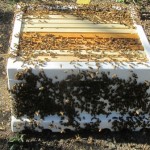
A hive box without its lid. The bees do a waggle dance to tell the bees still in the air that this is their new home
The work on the trellis that will serve as our grape arbor was nearly complete when the swarm occurred. Now the finishing touches will have to wait for another day.
De-Bugging My Honeybee Hive Box of Beetles
I’ve been dealing with a beetle problem in my honeybee hive since fall. When my knowledgeable beekeeper neighbor called to suggest opening the hive, I readily agreed.
The dreaded hive beetle–tinier than a honeybee–can destroy a hive. Its destruction isn’t on the bees themselves, but rather the comb, honey, and pollen. As the population of hive beetle increases and the destruction mounts, the bees will abandon the hive.
Previously, my neighbor had used two types of hive beetle traps in my hive–Beetle Bee-Gone was an all-natural, chemical-free sheet that looked like a fabric softener product for the dryer. We had placed this on top of the frames before closing the hive last fall. The other product was a narrow plastic tray inserted between the frames that held vegetable oil.
We discovered that the sheet worked well, trapping lots of hive beetles. But the frame with oil had no beetles. I dumped it. We checked the brood box–and were excited to see it full of unborn babies.
After harvesting eight frames of honey, we reversed the brood box, scraped away the burr comb, and positioned a super on top of the hive box with empty frames for spring honey. Before closing the hive, we inserted two clean sheets of Beetle Bee-Gone.
Today, the bees are active and out foraging for pollen. Flowers are everywhere and the fruit trees in the neighborhood have broken bud. It remains to be seen if the Bay Area gets any more rain or bitterly cold days ahead. Probably by April 1, I’ll hang the swarm catcher and hope to add a new population of bees to my colony.
______________________________________________________________________________
If you enjoy reading about keeping bees, growing heirloom vegetables and fruits, caring for chickens, or self care for healthy living, check out my Henny Penny Farmette series of cozy mysteries: A BEELINE TO MURDER, THE MURDER OF A QUEEN BEE, and HIVE OF HOMICIDES. Click on the URL below. Also see newest nonfiction for healthy living: RITUALS FOR LIFE.
http://tinyurl.com/ya5vhhpm
Beauty in the Garden–Butterflies and Other Pollinators
I enjoyed studying botany and zoology in school, but never felt attracted to the study of butterflies, bees, beetles, and bugs with any kind of intensity. I regret that. Not only because some of these pollinators are beautiful, but many are also beneficial to gardens and orchards.
As a beekeeper, it’s my job to notice moths, hive beetles, and other flying and crawling insects. Though some are beautiful and beneficial, others can harm my honeybee hives. That’s why when walking around my garden, I pay attention to all sorts of creatures–whether winged or not.
I do love to see butterflies and Lady Beetles (also known as ladybugs, a beneficial garden insect) amid my flowers, bushes, and trees. Today, I spotted a lovely winged creature with black-and-white patterned wings and a blue body.
It stood out against the green leaves of plants in my bee garden and waited for me to run inside the house to get my cell phone camera.
I wonder if anyone can correctly identify this blue-body, black-and-white winged flier for me. Could this be an Arrowhead Blue butterfly? These, I know, are found in Northern California and the Sierras.
Another pollinator that “posed” for me earlier this year is the longhorn bee. It’s about the size of a bumble bee. Some of these fliers are so lovely, I could see spending hours taking pictures.
But chores and all the other farmette tasks take priority over photography. Still, I hope the pictures are clear enough for someone to identify the species when I can’t.
* * *
NEWLY RELEASED–The Murder of a Queen Bee (Kensington Publishing, NY–Sept. 2016).
Discover recipes, farming tips, and sayings as well as sort out a charming whodunnit. Click on the link under the picture.
See, http://tinyurl.com/h4kou4g
See, http://tinyurl.com/hxy3s8q
This debut novel launched the Henny Penny Farmette series of mysteries and sold out its first press run. It’s now available in mass market paperback and other formats.
Lemon Oil for Luring Honeybee Swarms
Call it my sixth sense at work, but after my bees acted aggressive (which they usually are not) as I cleaned the water fountain, I prepared the swarm catcher and put it in the apricot tree nearest my office window. Mid-morning on Wednesday, I got my first swarm of 2016.
Lemon oil is often the ingredient that lures the honeybees to a swarm catcher. I mix the lemon oil mixed with water and spray the swarm catcher with a pump sprayer. It usually works better to capture the bees in the swarm catcher than having them coalesce en masse on an inconvenient limb in a tree, say, fourteen feet up.
You can use lemon oil as a salve or in the oil form–apply the salve onto the swarm catcher around the opening for the bees or use the oil in a small plastic vial that gets inserted into a swarm catcher orifice.
Bear in mind that not all lemon oils are equal. Some are more “lemony scented” than others. Lemon oil is cold pressed from the peel and contains 3 to 10 percent citral (considered the most powerful of components that contribute to the lemon scent). Lemon myrtle contains 95 percent citral and, if it’s the scent you want, lemon myrtle is superior to all others.
So, when I realized my bees were swarming, I suited up and prepared a hive box with ten frames, eight with wax from previous honey harvests (where I left the wax intact) and two that I had in the kitchen where I was draining honey from them. It would provide an immediate source of food for the bees in their new home.
Today, I visited my favorite shop for all things honeybees and stocked up on a couple more hive boxes, just in case of another swarm, although the bees are quiet and non-aggressive again.
Swarming Season 2016 Has Started
My beekeeper neighbor was working in his backyard this morning as I typed away on my novel. My office overlooks the garden and the fence between our properties.
Then . . . I heard the familiar clanging of a spoon against a pan. I leaped from my desk chair and ran to the kitchen. There, I grabbed a pot lid and wooden spoon and joined the banging at the fence between our properties.
I could see the brown cloud of honeybees in the air swarming near his apricot tree. We banged away for a while. It’s a bee-disorienting action that compels them to alight in a nearby tree or bush. “Have they landed yet,” I yelled. He replied that they had.
Thus begins the 2016 swarming season for the environs of the Henny Penny Farmette.
The Bees Won’t Wait
With so many flowers in bloom now, it’s time to add supers to the hives.
I can hear the buzzing from my patio, about twenty to thirty feet from the hives. My bees want to make honey, raise babies, and swarm . . . I know it.
My neighbor and I are opening hives tomorrow, but I worked out in the apiary today getting extensions (known as supers) ready. These have shorter frames and the bees use them to build wax cells and store honey.
I’ve got two active hives and extras. And I have several supers, complete with the shorter frames ready to go.
There are about ten frames I can use in a super that are being housed in the outdoor freezer. It’s where I put frames to kill anything that could live over on them that I don’t want in a hive, like a wax moth. The cold kills.
I also cleaned the bee glue off another hive box with larger frames in the event the bees decide to swarm sooner rather than later. The bees won’t wait. They’ll need a new house ready when they swarm or they’ll fly away and find one elsewhere.
 Facebook
Facebook Goodreads
Goodreads LinkedIn
LinkedIn Meera Lester
Meera Lester Twitter
Twitter




